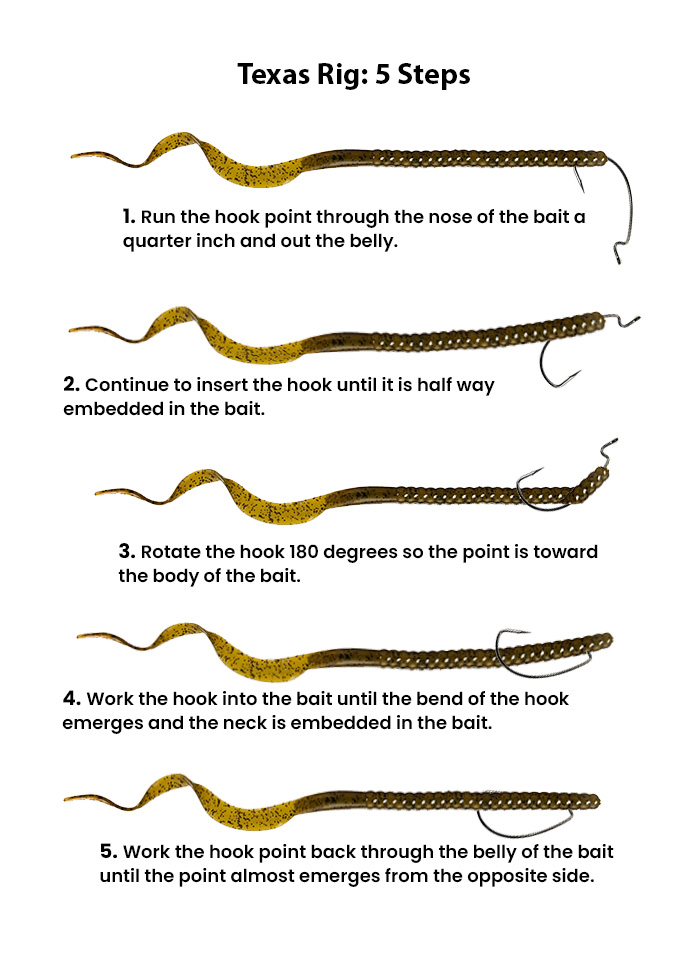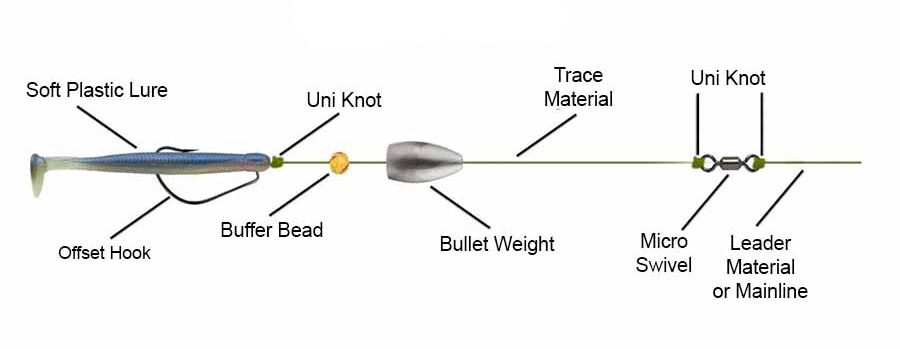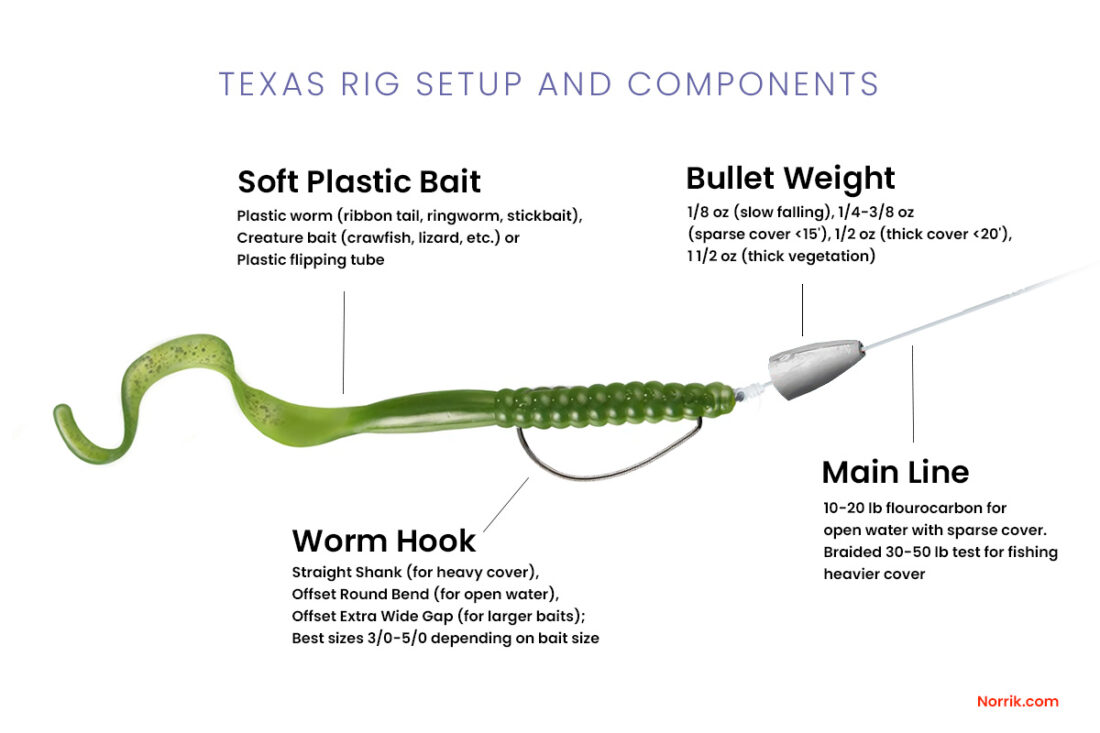The Texas rig (aka “T-rig”) is one of the most popular rigs for presenting soft plastic baits in areas where there is dense cover because it rarely snags. It is the ideal “weedless” rig for fishing in submerged vegetation, near underwater stumps, and in rocky areas.
The Texas rig is used primarily for fishing bass, pike and pickerel, but is also effective for targeting other warm water fish species that like to burrow in cover. The Texas rig is especially effective for catching largemouth bass that tend to forage in thick vegetation and weedbeds where other fishing rigs tend to snag.
- How to make the Texas rig: 5 simple steps
- Texas Rig setup options
- Recommended equipement specs
- Texas Rig hook selection
- Weight and sinker selection
- When and where to use a Texas rig
- Techniques for fishing a Texas rig
- Best baits for a Texas rig
How to make the Texas Rig: 5 Easy Steps
The basic components of the Texas rig include a soft plastic lure, bullet-shaped weight and offset hook.
A basic Texas Rig setup does not require a weight. However, most anglers will thread a bullet-shaped weight on the main fishing line. The weight increases casting distance, ensures the head of the lure remains in the proper position as the lure swims through the water, and it helps avoid snags and vegetation buildup on the line.
The Texas rig does not require a bead. However, some fishermen like to add a bead because it creates a clicking noise that makes a sound similar to that of a crayfish moving along the bottom. The bead’s bright color can also help the rig be found by feeding fish when water is cloudy. Add the plastic or glass bead to the line just under the weight.
If you choose to use a bullet-shaped weight and bead with your rig, they should be added to the line before you create the rig. Once the weight and bead are added to the line, tie your line to your hook and follow the following five steps for setting up a Texas rig using a wide gap offset hook.

- Take your hook and push the point through the head of the soft plastic a 1/8 to 1/4 inches into the body of the bait and out through the belly.
- Continue to insert hook until is about half way embedded in the soft plastic bait.
- Rotate the hook 180 degrees so the point is now pointing back toward the body of the soft plastic.
- Continue to work the hook through the bait until the first bend of the hook emerges from the belly of the bait. The neck of the hook should now be entirely emerged in the bait with the eye of hook barely visible at the nose of the bait.
- Work the point of the hook back through the soft plastic until the hook doesn’t quite emerge from the surface of other side of the bait, or barely protrudes.
Having the point of the hook under the surface of the bait enables the hook to travel through the water without snagging. When a fish bites down on the bait, the hook releases from the plastic worm and sets in the fish’s mouth.
Texas Rig setup options
The Texas rig can be dressed with a variety of soft plastic baits in order to imitate the natural prey of the target fish species. These include, but are not limited to craws, lizards, frog baits, beaver baits, flipping tubs, creature baits, tube baits and baitfish imitators.
The following diagram shows a complete Texas rig with a soft plastic paddletail baitfish imitator, a bright orange bead, bullet weight and swivel. You’ll note that in the diagram the hook point is just protruding from the surface of the bait. If you want to minimize snags and hangups when fishing in dense cover, make sure the hook point is embedded just under the surface of the bait as shown in the “Texas Rig: 5 Steps” diagram above.

The Texas rig can also be made using a slip sinker instead of a weight that is fixed in place. Allowing the slip sinker to move up and down the line when fishing in open water creates a natural effect.
In extra-thick cover, it is better to place a pegging device or bobber stop above the slip sinker to position it close to the hook and inhibit the sinker from moving up the line. This will help you pull the lure through heavy cover without snagging or loosing your bait. When fishing the Texas rig in open water, it’s better to leave the sinker unpegged so the lure exhibits a more natural action.
Recommended equipment specs
A Texas rig can be fishing with a variety of equipment. It will fish well using either a baitcaster or spinning tackle. Since Texas rigs are often used to fish heavy vegetation I recommend a medium to heavy action rod. When you’re retreiving through heavy cover you want a rod with some backbone.
Rod length isn’t as vital but it’s still important. A 7 to 7’6″ medium heavy rod with high speed gear ration (7:1) will provide the leverage you need to get a clean hookset when you have to take up slack in the line quickly. Remember, the Texas rig is a weedless setup so you have to hit the fish hard on the retrieve to force the hook through the surface of the soft plastic bait and get a good hookset.
If you’re fishing sparse cover, or open water with high clarity, a light weight 10 to 20-pound flourocarbon line is ideal. This line is less visible to wary fish. In heavier cover, we recommend using a braided line. Braided has very give and provides for a greater hookset. Due to its small diameter you can use a heavier line in the 30 to 50-pound test range.
Texas rig hook selection
There are several hook types that work well with the Texas rig. The three most popular are the straight shank, offset wide gap and offset round bend. Each hook offers unique benefits when fish using the Texas rig.
| Hook type | Description |
|---|---|
| Straight Shank | The go-to hook for the majority of Texas rig setups. Ideal for short casts and fishing heavy cover. Provides life like action as the bait falls through the water column and upon retrieve. Has a comparatively high hook-up ratio due to the smaller gap space between the barb and eye of the hook. Once the hook is set, fish rarely escape. |
| Offset Extra Wide Gap (EWG) | EWG is ideal for large, thick soft plastic baits. The larger gap between the hook point and eye provides additional space to accomodate both bait and a positive hookset. Baits are easy to thread using the EWG, but the larger gap and barb that directly aligns with the hook eye leading to a greater chance of losing fish after it's hooked. |
| Offset Round Bend | Competes with the straight shank in popularity. The offset shank provides for rigging larger soft plastics including bulky worms and creature baits. This hook allows the bait to sit well below the eye and it penetrates soft plastic bait further down the body. It is used when fishing the Texas rig in open water and sparse cover. |
As you consider the best hook size for your Texas rig, don’t forget to consider bait size. It’s important that you don’t use a hook that’s too large for your bait, or vice versa. I recommend using as big of a hook as your soft plastic can handle, but no larger. You’re typical 6-inch plastic worm will take a 3/0 straight shank hook. A 7-inch to 8-inch worm will take a 4/0 hook. Worms between 10-inches and 12-inches will take a 5/0-6/0 hook.
The following chart shows recommended T-rig hook sizes for various plastic bait types and sizes.
| Bait Type | Hook Size |
|---|---|
| Plastic Lizards, 6-inch plastic worms | 3/0 straight shank |
| 7- to 8-inch plastic worms | 4/0 straight shank |
| 10-inch or longer plastic worms | 5/0 straight shank |
| Beaver baits and craws | 4/0 EWG (extra-wide gap) |
| Creature baits | 5/0 EWG |
Weight and sinker selection
Selecting the correct weight bullet slip sinker is essential to creating an effective Texas rig presentation. If you use a sinker that is too heavy, there’s a good chance your rig is going to drag and you’ll constantly be popping your bait to get through cover. One the other hand, if you’re sinker is too light, you may not be able to penetrate the cover at all. As a rule of thumb, the lighter the cover the lighter the weight.
For the Texas rig, sinker weight should be determined by several factors including water depth, thickness of the cover, and fishing conditions. The following are just fews suggestions for sinker weights based fishing conditions.
| Fishing conditions | Weight size |
|---|---|
| Slow-falling lure for shallow water | 1/8-ounce |
| Sparse cover with depth less than 15' | 1/4- to 3/8-ounce |
| Thick cover with depth over 20' | 1/2-ounce |
| Thick vegetation | 1 1/2-ounce |
When and where to use a Texas rig
The Texas rig is known as the go-to rig for fishing bass and other fresh water predatory game fish that hang out in and around heavy cover. Its compact, weedless setup is ideal for working thick vegetation while maintaining a natural presentation and snag free retrieve.
The Texas rig is the ideal presentation for the following conditions:
| Fishing conditon | Usage and description |
|---|---|
| Heavy cover | The Texas rig is completely weedless and is ideal for fishing in thick weeds, matted vegetation, underwater structure, or underneath docks. |
| Bluebird Days | A Texas rig is the go-to rig for bright, sunny days when bass are holding tight to vegetation. The Texas rig will lure bass out of vegetation and get them to strike. |
| During and after spawn | Presenting a Texas-rigged plastic lizard, creature bait or craw into the nest of a bass, or a Texas-rigged finesse worm into a ball of young bass fry will often trigger a protective strike. |
| Fall/autumn | During the fall when bass are in the shallows, working a Texas-rigged finesse worm or creature bait around cover is effective for triggering a strike. This setup is effective during cold fronts when bass are less active and when fishng pressure is high. |
| Shallows | The Texas rig can be fished at any depth, but it's ideal for fishing shallow waters because it can be rigged with light weights (as light as 1/8-ounce). |
Techniques for fishing a Texas rig
The general approach to fishing a Texas rig is to retrieve it slowly along the bottom as you work it through rocks, vegetation and other structure. This is the perfect technique for targeting large, lethargic bass that are just waiting for a meal to present itself. However, there are several more effective presentations that will get a monster bass, northern pike or hungry muskellunge to bite.
The following chart covers the most popular techniques for fishing a Texas rig.
| Technique | Description |
|---|---|
| Dragging Retrieve | Cast the Texas Rig out and allow it to sink to the bottom. Drag the lure across the bottom 2 to 3 feet by slowly raising the tip of the rod. Reel up the slack, and repeat. Ideal for fishing rock bars, gravel, and steep banks, and when fish are bottom feeding on crayfish. |
| Flip and Pitch | A simple technique where you hold the Texas rig in one hand and then swing it in a pendulum motion to a target location on the water. This technique is used in tight quarters. Effective for fishing docks, bushes and weed cover where space is limited. |
| Lift and Drop | Cast the bait to target location and let it sink to the bottom. Lift the bait a foot off the bottom and allow it to fall back to the bottom. Shake the rod tip occassionally to elicit bites. Use when bass are actively feeding during the summer. Best bait is a Texas-rigged 4-inch tube bait. |
| Simple Swim | Cast the bait out and retrieve it at various speeds. Jerk the rod tip occassionally to create erratic movement and trigger strikes. This technique is used to target feeding bass in weed flats, vegetation and around large structure. Best baits are soft plastic grubs, finesse worms, and swimbaits. |
| Weightless Twitching | Use a Texas rig without a weight. Cast the weightless rig into weed flats or vegetation at a shallow to mid depth. Allow the rig to sink to the desired depth, then twitch it in place using short lifts of the rod tip. A twitch followed by a very brief pause is most effective. Ideal setup includes a 3/0 EWG hook with a shad jerkbait or stick worm. |
Best baits for a Texas rig
Texas rigs are highly customizable and can be used to fish about any soft plastic bait that makes sense for the target fish and water conditions. The following are some of the most common baits used with a Texas rig.
Plastic worm
The plastic worm is the quintessential soft plastic and number one bait used on a Texas rig. Worms are simple to rig, simple to fish, and get a bite every time. Worms come in various styles and sizes to match just about every fish species and situation.
Ribbontail worms and ringworms are the go-to baits for warm weather. A Texas rig with either of these baits is the perfect setup for fishing thick cover and reeling in bass all summer long. Ribbontails and ringworms range between 5 and 12 inches. There’s nothing better than a 12″ ribbontail on a T-rig to entice a monster bass onto your line.
As water gets colder in late fall, angler’s will use a Texas rig with a 1/4-oz bullethead weight and stickbait style soft plastic. This rig style is also effective when fishing bass spawning beds.
Creature bait
Second only to a plastic worm in its versatility and bass catching ability, the creature bait is the ideal T-rig bait when you’re trying to imitate a specific prey. For bass fishing, the most popular creature bait is the plastic crawfish. A hungry bass can’t pass up a juicy craw. Crawfish style soft plastics come in a variety of sizes and colors to match the hatch for the body of water you’re fishing.
You should match the size of your soft plastic craw bait to the local hatch as well as the size of your target fish. The best bullet weights for rigging a T-rig with a plastic craw range from 1/8-oz during the fall and cooler months, to a hefty 2-oz bullet weight during the summer when penetrating thick matted vegetation and underwater weed gardens is a must.
Common craw bait colors include green pumpkin, black, blue and watermon. However, I haven’t found that any one color necessarily works better than another. The key is to test different colors to see which works best where you’re fishing.
In addition to craws, there are a variety of creature baits including lizards and frogs that will also work with a T-rig.
Plastic flipping tube
Where the plastic flipping tube stands out from the pack is its action. A plastic flipping tube produces a unique action as it moves through the water that drives feeding bass wild. As a flipping tube falls through the water it flutters and moves in a wide circle. Its movement closely resembles an injured baifish or swimming craw.
While tubes are often used on a T-rig, they’re not as effective penetrating thick cover as Texas rig with a traditional plastic worm. Tube T-rigs work best in small areas where you know there fish and you just need to get the to bite. A tube works best with a lighter 1/8 oz to 3/8 oz weight.




